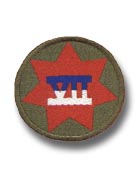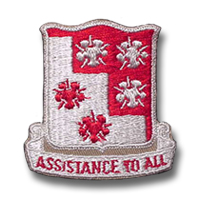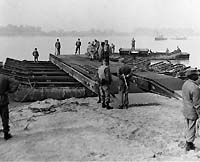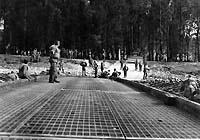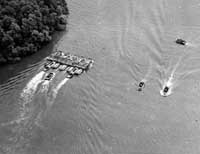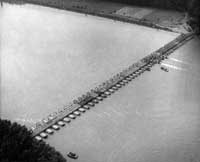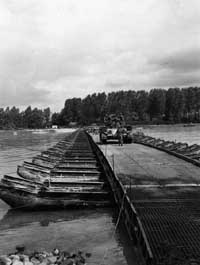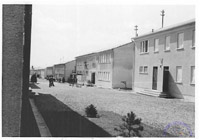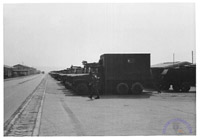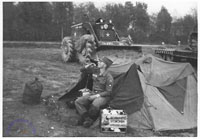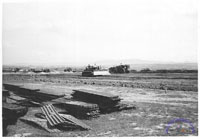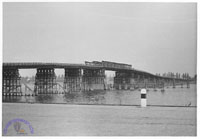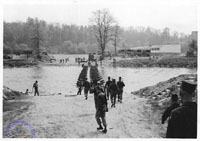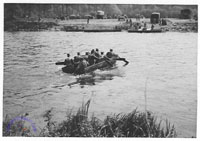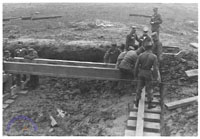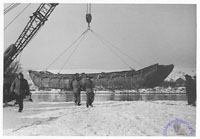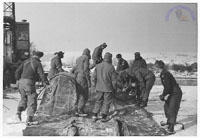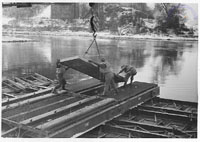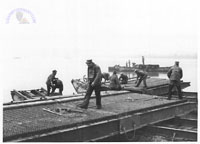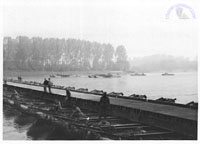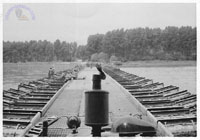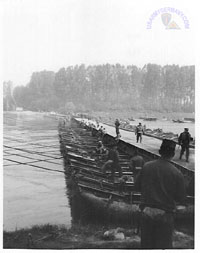| If you do
NOT see the Table of Contents frame to the left of this page, then
Click here to open 'USArmyGermany' frameset |
|||||||||||||||||||||||||
|
168th
Engineer Battalion |
|||||||||||||||||||||||||
|
|
|||||||||||||||||||||||||
|
|||||||||||||||||||||||||
|
|
|||||||||||||||||||||||||
| Battalion History | |||||||||||||||||||||||||
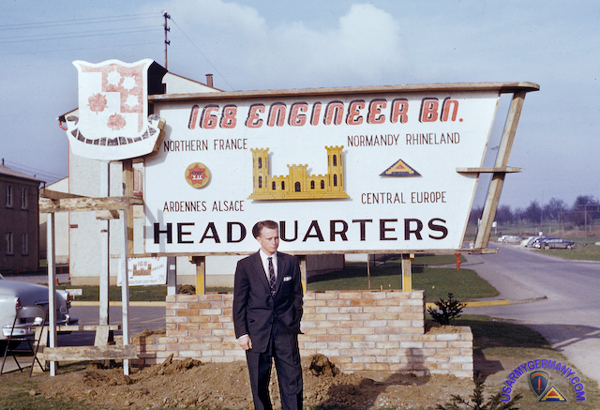 Warren A. Stickelman in front of 168th Engr Bn sign, Nellingen Kaserne, c. 1958 (Kevin Stickelman) |
|||||||||||||||||||||||||
| 1957 - 1963 | |||||||||||||||||||||||||
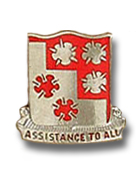 168th Engineer Bn DUI
168th Engineer Bn DUI |
|||||||||||||||||||||||||
| (Source: 168th
Eng Bn Unit History - 1957-63, by William Hokanson CPT, Bn Adjutant.
168th
Eng Bn Historical Archives website, 2002) NOTE: If you were a combat engineer and you were stationed in Germany in the 1950s, 1960s - check out the awesome photos in the website's "Photos - 1957-63 Nellingen, Germany" section!!!) |
|||||||||||||||||||||||||
|
|||||||||||||||||||||||||
|
The
wartime mission of the 168th was to provide direct combat engineer
support to the 24th Infantry Division as part of the VII Corps defensive
plan. The specific missions were primarily squad size, consisting
of bridge demolition, road cratering, abatis creation, and small
scale minefields. Because the 24th Infantry Division was then organized
under the "Pentomic" concept, it had five Battle Groups, each commanded
by a full colonel. Each battle group had five line infantry companies.
There were no infantry battalions in the division at that time.
To support the five battle groups of the 24th Division, the 168th Engineers had five line companies, A through E, and under NATO standardization of the phonetic alphabet, they were known as Alpha, Bravo, Charlie, Delta, and Echo. The battalion also had a Headquarters Company. It was not called "H&S" although it performed the same functions. The line companies each had three platoons and a company headquarters. Each squad had an authorized strength of twelve, but seldom exceeded eight or nine. Each squad had its own dump truck, initially 2 1/2 ton, but by 1961 they were 5 ton dumps. Each pulled a cargo trailer or pole trailer loaded with explosives and ammunition. Platoon leaders had jeeps with trailers and platoon sergeants had 3/4 ton utility trucks with trailers. The basic weapon was the M-1 .30 cal rifle, but these were replaced in 1960 by the M-14, which was similar but fired the standard NATO round of 7.62mm, used magazines of 20 rounds rather than the 8 round clip of the M-1, and could be fired on full or semi-automatic. Each squad was equipped with a 3.5 inch rocket launcher (bazooka). Two of the squads had .30 caliber machine guns and the third had a .50 caliber, all with tripod ground mounts. At that time, the line company headquarters had two D-6 bulldozers and two scoop loaders. The battalion's heavy equipment platoon had three additional dozers, several scoop loaders, three road graders, and three truck mounted 20 ton cranes. Like other combat engineer battalions, the 168th had a nuclear capability. It was trained to assemble and emplace Atomic Demolition Munitions. While small in yield, they were highly accurate, unless the emplacing officer could not read a map. Initially, each company had an ADM team consisting of an officer and several NCOs. By 1961, a special ADM platoon was created in each combat engineer battalion so that the specialized and sensitive training could be more centrally conducted and controlled. In addition to minefield and demolition training directly related to its wartime mission, the battalion trained continuously on the range of combat engineer missions to include bridging of all types, but particularly floating bridges. It also trained for its secondary mission to fight as Infantry when required. Company-size bridge training typically took place on the Danube near Ingolstadt where the span required was about 250 feet. Most often, the Class 60 steel treadway bridge was used, which required the use of cranes to place its 15 ft long sections. Companies of the battalion also trained on the M4T6 aluminum balk bridge which was hand erectable. Each year, the entire battalion spent an entire week training together to bridge the Rhine using Class 60 treadway bridge. The bridge sites used were just south of Speyer, or at Leeheim near Nierstein where Patton's troops first crossed in 1945. The spans here are 1,000 to 1,200 feet. Everyone looked forward to the Rhine bridging week because it was done in summer when weather was nice, the bivouacs were administrative, and the troops were permitted passes at night to visit the local gasthauses and nearby festivals. On Sunday, when the German government permitted full closure of the Rhine for brief periods for military training, the battalion tried each year to outdo its previous record, as well as that of its rival battalion, the 237th, in completing the bridge. All units, including the float bridge companies began in their bivouac areas. At a time given, carefully coordinated convoy movements began toward the river. Timing began when the first powered bridge construction boats hit the water and bridge assembly began. Typically, the bridge would be completed in slightly more than two hours. A few vehicles would make a ceremonial crossing, then the bridge had to be taken apart, the huge rubber pontons deflated, and all equipment reloaded on to bridge trucks. During its time in Germany, the 168th played important support roles during such large scale field training exercises as Free Play in 1959 and Wintershield I and II in late January of 1960 and 1961. These exercises pitted VII Corps against V Corps. In the opening phases of Wintershield I and II, the 168th built Class 60 bridges under near blackout conditions to support VII Corps assault crossings over the Danube near Kelheim and Regensburg and each time received high praise for its work. In the summer of 1962, the 168th was the first engineer battalion chosen by Seventh Army to spend a month at Grafenwoehr and Hohenfels performing badly needed maintenance and repair to tank trails, firing ranges, and other training facilities. As a result of the Berlin crisis of 1961, U.S. forces in Germany were beefed up to include the addition of another combat engineer battalion in VII Corps. This unit, the 82nd Engineer Battalion (Combat) was stationed at Bamberg north of Nürnberg. Consequently, in 1963, when tensions eased somewhat and some of the reinforcing forces were returned to the U.S., the 168th was chosen to return instead of the 82nd Engineer Battalion at Bamberg, because the 82nd was much closer to initial wartime positions. After six years in Germany as part of VII Corps and Seventh Army, the 168th departed Nellingen in August 1963 and returned aboard the USNS General Maurice Rose for its new station at Fort Polk, Louisiana. Only two years later, it was deployed to Vietnam. |
|||||||||||||||||||||||||
| If you have more
information on the history or organization of the 168th Engr Bn, please
contact me |
|||||||||||||||||||||||||
|
|
|||||||||||||||||||||||||
| (Source: 168th Eng Bn Unit History - 1957-63, by William Hokanson CPT, Bn Adjutant. 168th Eng Bn Historical Archives website, 2002) | |||||||||||||||||||||||||
|
|||||||||||||||||||||||||
|
|
|||||||||||||||||||||||||
| (Source: Email from Clark Frederic, Co E, 168th Engr Bn, 1960-62) | |||||||||||||||||||||||||
| Co. E, 168th Combat Engineer Battalion - Bridging the Rhine &
Winter Shield; Nelligen & Kelly Barracks; Germany 1960
to 1962. There was tension at the time, nothing like these days though. The Russians were sabor rattling and we were training, just in case. The 168th was stationed at Nelligen when I arrived then later we were moved to Kelly Barracks at Ludwigsberg. Most of the time we were in the field. We bridged the Rhine South of Spyer, I think we had the record. I had the time written down but can't find it. Winter Shield was cold and we drank to keep warm. My Company was in support of a German Panzer group & it was our job to keep them on the move in case the Russians decided to come across the Border. At the time they started the Berlin Wall and we were denied access to Berlin. It got a little hairy at times, but the Russians blinked first. I have some pictures of the Berlin Wall & Check Point Charlie. |
|||||||||||||||||||||||||
|
|||||||||||||||||||||||||
| (Source: Email from Luke Sexton, 168th Engr Bn, 1962-63) | |||||||||||||||||||||||||
| I was assigned
to the 168th from Feb 1962 to Aug 1963, when I gyroed it back to Ft.
Polk, La. (Luther M. (Luke) Sexton, Sgt, E-5, RA24605437) I came down from the 168th's parent unit at the time, the 555 Engr Gp, at Karlsruhe, on 7 Feb 1962. A Sgt Lee, from my old unit, had driven me down in a jeep. I was jawing with a friend of mine, the Personnel Sergeant, SFC Reed, between the Hqs and Personnel buildings, and unloading my bags from the jeep trailer. The Hqs Co Commander, a Captain Puhr, stuck his head out the window and yelled, asking me if I was being assigned to that unit. I told him, "I believe I am, Captain. You have the only slot in the Bn that I can be assigned to". He replied, "Get your records and report to me". SFC Reed told him "He hasn't even signed into the Bn yet". Puhr replied "I don't care, I want to see him and his records in my office, now". I told Reed not to worry about it, thanked Sgt Lee and sent him back to Karlsruhe, dug into my bags, got my records, and walked into the Orderly Room, greeting MSgt William F. Triggs, unit 1st Sgt, as I passed. I knocked on the commander's door, received an order to enter, did so, saluted and reported. Puhr held his return of salute, trying to get me to bring mine down too soon. I held but, when he seperated from his eyebrow, my hand was at my side, and I was laying the records on his desk before he got his hand onto the desk! He flipped through my records, leaving me at attention while he did so, then looked up at me and said, "I don't know what you're used to where you come from, Sergeant. But, if you f--- up here, I'll hang you from the highest tree". After I recovered, and got my mouth up off my chest, I told him, "That's a two-way street, Captain. If you f--- up, I'll hang you from the highest tree!!!". He handed my records back across the desk, and told me I was dismissed. We went through the same little charade of him holding the return of salute, hoping I would cut mine away. I held until his fingers broke contact with his eyebrow, then cut mine away, did an about-face and started out of the room before he got his hand back on the desk!!! As I walked out the door, MSgt Triggs (300 pounds of black mountain, who had spent a career jerking steel bridge beams around!) looked up from his desk, grinned, and said, "You and me gonna' get along just fine, Sergeant Sexton". I had been assigned on 7 Feb 1962. On 16 Feb, the IG arrived. The entire unit, as I understood it, had never passed an IG inspection. I had to hide two Deuce and a half truck loads of spare parts (one of which was a $35 Power Amplifier tube, which I was authorized three of, but had 57!), and get that section in shape for the IG in nine days. I worked almost non-stop for that nine days, but we made it. We got an "Excellent", with only one major gig keeping us from an "Outstanding" (one radio, out of 13, had a blown fuse. It blew as I shut the radio off when I checked it earlier that morning!). Captain Puhr had promised a day off for any section that got a passing grade on the inspection. Needless to say, since the section was a Battalion entity, he couldn't deliver on that, and we never got one from the Bn. In late 1962, Delta Company was deployed on the Danube. They couldn't get back to us by radio. Major McMullen, Bn Exec, and I had known each other for some time, back in Karlsruhe. He called me up, told me to grab my toilet kit and a change of clothes, and go up to the heliport, that a helicopter would pick me up in 30 minutes, to take me out on the Danube. We landed in a little open field, and I could see the radio truck as we hit the ground. I could also see what the problem was. They were using a 3/4 ton Weapons Carrier as a radio truck. They had taken the coaxial cable, from the radio to the antenna, and coiled approximately 100 feet of it around the rim where the spare tire normally would be!!! This created quite an impediment to RF waves, since the coil of coax, around that rim, formed one heckuva' barrier, turning all their RF energy around and feeding it right back to their transmitter!!! I unwound the coax, put on a set of tree-climber spikes, and shimmied up a couple of pine trees, tying their antenna off about 60 feet up, walked back to the truck and, feeling really cocky, fired up their smaller AM transmitter, a little 35 watt job, as opposed to the 100 watt transmitter they had been using, and hit the key. I instantly got a reply from back at Nellingen, with a 5X5 reading, and told my operator there to call the Exec and tell him the problem had been rectified! Time on site - less than 45 minutes! In approximately Sep 1962, an SFC Jim Norris, a bachelor with 17 years in, was assigned to the section, reverting me to to Radio Chief, while he became the Commo Chief. In early 1963, on a Monday morning, I was on duty in my Radio Room, downstairs of the barracks where Norris, another SFC and I shared a Cadre room. I knew Norris was supposed to take Reveille that morning. I also knew he was not there to do so. So, I took it for him, and returned to the Radio Room. At 0700, I was relieved, went upstairs, took a shower, and went to bed. I didn't quite get to sleep, when my Radio Operator came up and told me the 1st Sgt wanted to see me. I got up, put on my fatigues, and walked next door, to the Orderly Room. MSgt Triggs asked me, "Sgt Sexton, where's Sgt Norris?" Being loyal to my supervisor, I told him, "Top, I don't know where Sgt Norris is" (I didn't know. But, I had a very good idea!). He looked at me and said, "Well, I'll tell you what. You go over to S-2, find SSgt Gray, and you and Sgt Gray go find Sgt Norris and bring him to me". Of course, I replied "Yes, 1st Sgt", went to S-2, got SSgt Gray and a jeep, went down into Esslingen, to Sgt Norris' girl friend's house (whom I had introduced him to), got him and brought him back up to the 1st Sgt. Captain Puhr hung an Article 15 on him, and busted him to SP-5, suspended. Then, Legal told him that he couldn't do that, since the man was an E-6, it took a Major or above to bust him. So, they got a Bn Hqs Major to do it, but then found out they could only take him down to Sgt, E-5, since going to SP-5 would be considered a two-grade bust. In the meantime, about a month after the first incident, we went through the same thing on a Monday morning - I go over to the 1st Sgt's office, he asks me "Where is Sgt Norris?", and I reply that "I don't know where Sgt Norris is, Top". At that point, Triggs rests those ham hocks he calls hands on the desk, glares across the desk at me and says, "Maybe you didn't understand me. I asked you where Sgt Norris was". I figured, "What the hell, I'm not going to be intimidated, even by a man-mountain". So, I plant my little 185 pound knuckles (soaking wet!) right up against his, stick my nose right up to his, and say, "Maybe you didn't understand me! I told you I don't know where Sgt Norris is!". He grins from ear-to-ear, and says, "OK, you know the drill. Go get him and bring him to me". And, of course, I reply, "Yes, 1st Sgt!", go down to his girl friend's house, and bring him back to the 1st Sgt. Puhr pushed for vacation of the suspended bust, and Bn Hqs goes along with it, taking him down to Sgt E-5. Meanwhile, the paper work had been progressing right along. But, somebody forgot something, evidently. When the case got down to 7th Army Support Command, the Commander looked at it, and said, "Wait a minute. This man's got 17 years of spotless service and you're gonna' bust him for one screw-up?" (somehow, the original Article 15 wasn't in the package, only the second one!), reversed the bust and Norris got several months of back pay as an E-6 instead of an E-5, including P-2! After gyro'ing the unit back to Ft. Polk, in Aug 1963, I was attached back to 555 Engr Gp Hqs, awaiting a Port Call and discharge back at Ft. Drum, N.Y. I enlisted in the Air Force in Dec 1963, and was assigned to Karamursel, Turkey. Enroute to the Commisary one day, probably in mid to late 1965, I ran into an Army Major by the name of Goldstein. He had been the commander of Bravo Company, 168th Engr Bn, while I was in Hqs Co, and was now assigned as the Base Corps of Engr Representative. Luke Sexton |
|||||||||||||||||||||||||
|
|
|||||||||||||||||||||||||
| Air Section, Hq Company | |||||||||||||||||||||||||
| 1959 | |||||||||||||||||||||||||
| (Source: Email from Ronald St. Peter) | |||||||||||||||||||||||||
| I was at Nellingen airfield from 1959 to 1961. I got an early out in 1961 after 24 mos. in Germany.
I was a helicopter mechanic for Headquarters Co., 168th Engr. Bat. Was on Operation Wintershield and spent more than half my time in field. Our helicopter was a small recon helicopter and Capt. John Olmstead was our pilot. When we went into the field I drove a gas tanker with aviation gas on board, 1600 gal. I lost my brakes once going down Java Junction ( about a 10 mile stretch on a good road down a mountain ). We were going to our forward position when Russia gave us 6 mos. or less to get out of Berlin. My air tanks ran out of air from braking so much going down the mountain plus I found out I had a small leak in the air line. I was going so fast that the speedometer was past 65 and around 0 again. In 5th gear I couldn't keep it in gear anymore so I raced the engine with the clutch in and built up the air pressure so I could start braking again. I was always the last truck in the convoy because of the aviation gas, so going up Java Junction I had to use low low gear and the rest of the convoy got way ahead, by miles. So going down was almost coasting and gaining speed. The truck that was ahead of me was carrying troops and a trailer with ammo on board. As I was trying to slow down I could see the truck and trailer coming up as I drove around the curves. Finally the pressure started coming up, 20lbs, 30lbs and I started to brake. God was with me that day because it worked and I slowed down, up to about 20 feet from the trailer ahead of me. As you can tell, I still talk about it. I spent a lot of time in Stuttgart, and had a girl in Ludwigsburg. Spent a lot of time in tbe Gausthaus Italia in town. I had a lot of fun in Germany. Fights would break out at the gausthaus and when I tried to help the other guys would push me down in a chair and say, " wait till we're done " because I only weighed about 120 lbs then and they would't let me fight. I still had a lot of fun!! ADDITIONAL INFORMATION I only worked on the H-13 and maintained it. I also drove a gas tanker with 105 octane aviation fuel when we went into the field. We were located in the hangar on the airfield off to the side. I remember the area where a tank used to sit when the Germans operated the airfield during the war. It was built like a ramp that went from ground level to about 8 feet in the ground with doorways in each side in the ground. There was rumor that there was a machine shop under the hangar and the entrance to it was sealed because of fear that it was sabotaged. That was never proven. That hanger is gone now and I wonder if the rumor was true. In the hangar were kept the H-34 helicopter and the medic H-19 helicopter. We also had a shop van, like a 2 1/2 ton truck with a box on the back with doors and a heater for winter. We had work bench inside with bunks for the 3 of us. I looked at Google earth at Nellingen, and there is no evidence that an airfield ever existed there. Plus I found one website that showed the barracks being torn down. That was in 1996. It's sad to see that all gone. Ii is hard to remember everything that went on, but I would do it all over again!! |
|||||||||||||||||||||||||
| Related Links: 168th Eng Bn Historical Archives website, a truly GREAT website. ----(12-15-2002) Link is dead! - anybody know if the site still exists? |
|||||||||||||||||||||||||
